|
FAQs on Freshwater Worms of All Sorts
2
Related Articles: Invertebrates for Freshwater Aquariums by
Neale Monks, Choose Your Weapon: Freshwater Fish Disease
Treatment Options by Neale
Monks,
Related FAQs: Freshwater Worms 1,
Planaria,
FW Worm
Identification, FW Worm
Behavior, FW Worm
Compatibility/Control, FW Worm
Selection, FW Worm Systems,
FW Worm Feeding, FW Worm Disease, FW Worm Reproduction & FAQs on:
Worm Caused Diseases,
Platyhelminths/Flatworms: ( Flukes, Planaria, Tapeworms and Leeches), Acanthocephalans, Nematodes/Roundworms (e.g. Camallanus),...
Anchor "Worms": See FW
Crustacean Parasitic Disease, & Worms as Foods, FW Invert.s 1, Aquatic Insects, Crustaceans, Shrimps, Terrestrial Hermit Crabs,
|
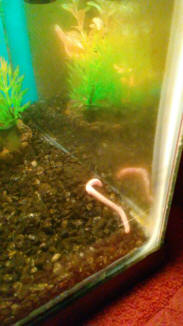
|
|
Need help to identify a worm 4/20/20
Hi,
I found a worm outside of my house, just near to my dog, when I accidentally
step on it. After looking it I found this so weird because it is first time
i have ever see worm with glowing blood. I have attached pic
of it, with flashlight and without flashlight. Is it baby millipedes? So
confused.
<Hello. That's quite the find! It appears to be a polychaete rather than a
centipede or millipede. I say that because the body appears to be soft, with
no obvious exoskeleton, unlike those two arthropod groups. A
polychaete ('bristleworm') seems more probable than an oligochaete
('earthworm') because of the fleshy appendages on each segment. However,
terrestrial polychaete are very rare, unlike oligochaetes, which include
numerous terrestrial species. So my guess in the absence of any other
information would be that this is a marine polychaete, perhaps dropped by a
bird onto dry land somewhere near your home. Of course if you live near the
sea, this makes sense -- but if you're more than a few miles inland, that
would be an unlikely explanation. There are freshwater polychaetes, but
they're mostly quite small and unobtrusive, and not at all common.
Fluoresce in polychaetes is quite well documented, though again, to the best
of my knowledge only among marine species. Better photos of the head end of
the animal would help -- polychaetes usually have obvious jaws complete with
sharp pincers in many cases, as well as eyes and tentacles, all of which are
absent from most oligochaetes. It would also help to know where you live. In
the Southern Hemisphere, velvet worms might also be considered, but you
wouldn't find these in Europe or North America, and again, they only live in
specific habitats such as rain forests. Cheers, Neale.>
|
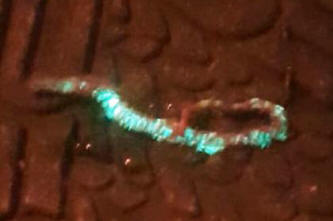 |
Long thin worm like creature hanging from outlet of
gravity filter
Hi
Hope you can help. Over the last several days I have noticed a thin
(maybe 0.5mm in dia) white strand of something hanging down from the
outlet of my built in gravity filter on my Aqua One UFO 550 tank.
<How odd.>
Today, I noticed it had grown in length substantially and when I
tried to grab it with some tweezers, it suddenly and quickly
retracted back into the filter outlet, so whatever it is, it’s
ALIVE! I estimate it to be between 100mm and 120mm long and think it
is some kind of worm, maybe feeding in the water current and living
in the part of the filter that contains the ceramic biomedia.
<Sounds like it! But really would need a picture to be sure.>
The Tank has 7 Angelfish and 3 Bristle Nosed Catfish and 6 Golden
Apple Snails and all seem healthy. Water quality is well maintained,
pH 6.8, Ammonia 0.25ppm, Nitrate 20ppm and Nitrite 0ppm and I do a
regular (3 to 4 week) water change of ~30 litres and always add
Prime.
<Apart from the ammonia, all seems fine. Zero ammonia is always the
aim, and whole at pH 6.8 you'll have less toxic ammonium rather than
free ammonia, do think about whether stocking, feeding, and
filtering are adequate. Do also check the ammonia level of your tap
water.>
Any idea what it may be and is it dangerous to the livestock?
<Unlikely. There are various free-living nematodes and especially
oligochaetes (such as California Blackworms) that can get into fish
tanks. They don't really do any harm, and can actually do some good
in 'deep sand bed' settings. With that said, in excessive numbers
they can indicate too much organic material (i.e., food) in the
tank, which shines a light on maintenance and stocking.>
If so what’s the best way to get rid of it.
<Well, the obvious is to open up the filter and take a look! If it's
a free-living nematode or oligochaete, you can either remove or
leave it in there, depending on your point of view. I set up little
critter tanks around the house (basically large jars on windowsills)
to observe anything like this I find in my pond or my daughter's
Triops tank. It's a fun addition to the hobby.>
Thanks
Bryan
<Cheers, Neale.>
Worms in freshwater substrate 4/23/18
I found several of these worms buried in the substrate of my 46gal
bowfront, today. Any idea what they are, if I should get rid of them and
if so, how? They’re about 1mm thick, and maybe 1.5 - 2” long at a guess?
They were pretty upset to be disturbed and all balled up. There are two
balled together in this video.
Thanks!
<No video attached. But as a general rule, freshwater worms are
harmless. Beneficial, even. Do look up freshwater Oligochaetes for
examples of the 'good' kind of worm. California Blackworms are quite
common and used in freshwater deep sand beds. Tubifex less positive in
the sense of preferring/indicating relatively dank conditions, but in
themselves harmless, even enjoyed as food by most fish. Cheers, Neale.>
shallow dug well. Worms? 8/7/17
I’m seeing whitish worms like angel-hair spaghetti in my dug well
decades old. Might these be dangerous parasites (nematodes) or some
such?
<Mmm; not likely dangerous, BUT I would have a water quality outfit
check them out>
Some approach 7 or 8 inched in length.
I am no longer drinking this water. But have for decades.
Help!
thanks for any info,
ed
<Most worms are not harmful to humans; including the vast majority of
Nematodes. Bob Fenner>
|
What the heck is this?! 2/13/17
I walked in to find this crazy white worm lookin back at me. It is probably
about 2 inches long and my Beta is scared half to death of it. What is it
and is it dangerous? I keep up with the tank cleanliness and don't over feed
my fish. What else could I do to prevent this from happening again?
-Hannah
<It's an earthworm or something similar (i.e., an oligochaete). Probably
unhappy being underwater, though there are one or two truly aquatic species
that sometimes appear in batches of live food. If it's an earthworm, could
you could kindly return it to the nearest compost heap or clean patch of
soil, that'd be great. Earthworms are fantastic animals. There's a great
book about them -- "The Earth Moved: On the Remarkable Achievements of
Earthworms" -- that I'd recommend to anyone. Aquatic Oligochaetes should be
returned to streams or shallow ponds. Compare and contrast your creature to
photos of the Oligochaetes native to your particular country and act
accordingly. Cheers, Neale.>
|

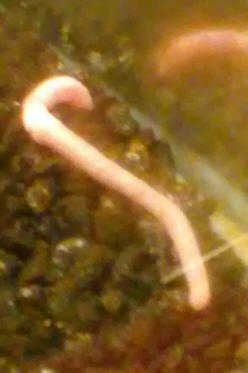 |
|
Worms in planted tank. 11/21/16
Hello everyone.
I have written before about my Hillstream loaches, which I still have and are
still breeding. Thank you again for your help with my loaches. I also have a 60
litre planted tank, 24 " long, 12" wide, 12" deep that has been set up for 3
months now. Ph 7, ammonia 0, nitrite 0, nitrate 5. External filter rated at 800
litres an hour. It's a planted tank with jbl Manado
substrate. There are 7 Boraras brigittae, 3 Otocinclus catfish and red cherry
shrimp. I also have these worms in the substrate which hopefully are not harmful
to my livestock.
<Probably not, but they're huge! Never seen anything like them. They look like
they're round in section, which rules out planarians. Their size seems much too
big to be free-living nematodes, and they seem to lack obvious bristles, which
rules of Polychaetes. That leaves two options, Oligochaetes and leeches. Leeches
sound alarming, but many species are predators, not parasites, feeding primarily
on small crustaceans and insect larvae. Common enough in ponds, these
free-living leeches have a flattened body and swim, rather than burrow.
Furthermore, their swimming is distinctive, undulating,
almost like a snake. On top of that, they have obvious suckers at each end, so
can't really be mistaken for anything else. Oligochaetes are earthworms and
their kin: if these worms have an earthworm-y appearance and behaviour, they're
probably Oligochaetes, virtually all of which are harmless detritivores.
Lumbriculus spp. are among the best known, for example the California Blackworms
sometimes kept in aquaria as part of a freshwater deep sand bed; while Tubifex
spp. are familiar to aquarists (especially older ones!) as a cheap but sometimes
dirty live food.>
A photo is attached. Hopefully the photo this time isn't too big. Any help in
identifying these worms are much appreciated. Carol.
<Hope this helps, Neale.>
|
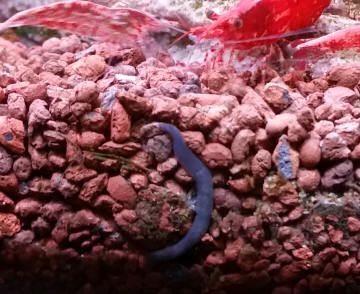 |
|
Re Worms in planted tank. 11/22/16
Carol; would you pls re-size and re-send your email? Just a couple hundred
Kbytes... not twenty megs. Am in Africa and there's no way I can dnld. such
files. B
Video from Carol Lucas 11/22/16
Thank you for your response. This is the smallest I could get the video at
the moment. The quality isn't great. Hopefully it will work. Thank you.
Carol.
<Who is this for? I can only download a few percent of this in an hour. Bye.
B>
re: Video from Carol Lucas 11/22/16
Sorry. I spoke to Neale yesterday.
<Ah; thank you. Could you post your video to YouTube or such and (just) send
along a/the link? BobF>
Re: Blackwater for Featherfin catfish?
Am out in Madagascar... can only download files of a couple hundred Kbytes.
Not yours of 16.5 Megs. Deleted. Re-size and re-send. B
|
|
Worms in my tank! 5/29/16
Hi, I have found a heap of tiny thread like worms in my freshwater
tanks.
They seem to be float/swimming around in the water but haven't seen any
on the glass. In the water they look white but when I get them out of
the water they turn pink/red. I'm worried they are detrimental to my
fish and/or tanks.
<They are not.>
I've searched your other worm related articles but ant seem to find a
description that fits. I have attached some photos below. If you are
able to help me understand what they are and the dangers of them in my
tank I would be very appreciative!
<No danger at all. But do indicate surplus organic matter for them to
feed on, whether directly or via the microbes acting as decomposers.>
The tanks they are found in house Bristlenose catfish, and various other
L number catfish so the tanks can get quite messy between cleans (each
weekend). Thanks in advance for any and all advice!
<Answered your question right there. I'd ignore them, but I'd also keep
a better grip on tank cleanliness, so that over time the populations of
worms declined. Too much organic matter in the tank means your filter is
having to work harder than it should, and nitrate levels are going to
end up a bit higher than they would otherwise. Cheers, Neale.>
|
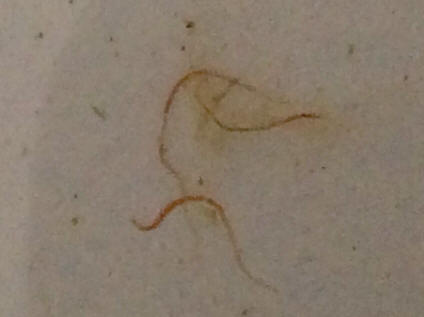 |
|
Re: Worms in my tank! 5/29/16
Thank you VERY much Neal! I was starting to panic.
<Oh!>
The tanks that house the catfish are my two bottom racks so gravel vaccing
is always difficult using traditional gravity fed vacs but I do use the
Eheim quick vac pro that is battery operated
<Never found these much use, to be honest.>
and 50% water change each Saturday.
<Much more useful.>
I may need to look at how my tanks are set up and remove the messier cats to
a higher tank to make gravel cleaning more effective. As long as I know they
are not something harmful I can deal with this. Thank you very much!
<Welcome. Neale.>
|
Planaria or similar in freshwater tank
8/29/15
Hello, I am writing due to an issue I am having in my freshwater tanks. I have
several, including one community, one invertebrate, one snail only and one
Corydoras only. The issue with the worms began in my invertebrate tank.
Honestly, this freshwater home is what I call a "mercy tank". I started it to
save the uninvited guests that I would often find in newly purchased plants,
driftwood, etc.
<It sounds a really neat idea.>
This small tank now inhabits few species of dwarf shrimp, "pest" snails and most
recently Planaria.
<Planarians are safe and common inhabitants of fish-free aquaria.>
I assume these problematic worms to be Planaria based on what I have read in
prior posts on your site. They are tiny, skinny, white worms that seem to do no
harm to those around them.
<Correct. They're fascinating animals under a microscope too, with all sorts of
weird biological quirks to read up on.>
Plus I have to admit I often neglect the mercy tank since it isn't something I
enjoy having.
<Benign neglect isn't a bad thing.>
Regardless, it is not filthy at all..and because of the dwarf (grass) shrimp I
take better care of it than I normally would. After spotting the small worms, I
began to clean the mercy tank more frequently. I have seen an improvement.
<Correct. Planarians like these will be feeding on organic detritus, and the
more you clean the tank, the less food for them.>
Now, to the problem! I always rinse my tools in hit tap water before switching
tanks, but today I suddenly saw a few of these white worms in my snail tank.
This tank is not neglected or overfed. I am confident that the worms were
transferred due to lack of proper sterilization of my equipment.
Am I possibly correct?
<Likely so, but could just as easily got there via aquarium plants or the snails
themselves. Most aquaria (probably all) have at least some planarians in them,
but being very small and often nocturnal we rarely see them.>
I have read about fluke tabs on your site. Are these safe for snails?
<Almost certainly not. It's a pretty obsolete medication that's not widely
recommended anymore. Lots of horror stories on the Internet if you can to
peruse. GeoChem "No Planaria" is a much better alternative.>
I would like to end this issue before it spreads to the tanks in which my fish
inhabit. Plus, I am grossed out!
<Dipping shared equipment in aquarium steriliser will prevent
cross-contamination, but bear in mind numerous fish will eat flatworms when
hungry, so it's pretty rare for them to become a problem in FW aquaria unless
that tank is seriously neglected/dirty.>
Please help.
Thank you,
Felicity
<Cheers, Neale.>
Want to add toy original email: paranoia or something similar
8/29/15
I just noticed that my snails seem to be bothered by something I can't see.
Two of my Malaysian trumpet snails were climbing the glass to the surface, then
appeared to be shaking.
<MTS will rise to the top of the tank to get to the oxygenated water if the tank
conditions aren't good. If you see them climbing the glass during the day, as if
abandoning the gravel, that can be a bad sign (at night its normal for them to
climb on the glass).>
I have a mystery snail as well that looks as if it is biting or scratching it's
body directly under it's shell. They all look irritated.
<Possibly so. Check water quality and pH.>
Is this a vicious species of Planaria or am I dealing with something much
worse??????!!!!
<There is indeed a predatory flatworm called Procotyla that will attack small
prey, even baby shrimps (though not fish). Cheers, Neale.>
weird tiny pink worms?
6/23/14
Dear WWM crew,
<Jen>
I do not have an aquarium, but hope you can help with a weird
water-related
problem. I have an old cat that sometimes drinks from a running water
fountain with a charcoal filter. The filter is very basic, just a small
plastic cartridge with charcoal pellets, and there is a piece of fuzzy
white fabric that keeps the pellets from dropping out of the cartridge.
Generally, I only clean the hard plastic portions of this fountain, but
today decided to take apart the filter. There were some pinkish orange
bits that looked like mold embedded in the fuzzy fabric. I took
everything
apart, tried to rinse the pinkish bits out of the fabric, cleaned what I
could, and let it all dry next to my sink.
<Mmm; I would bleach all the unit but the carbon... likely the carbon
has
removed enough of the sanitizer (chlorine based) that some "critters"
have
been allowed to become situated...>
Hours later, I was disgusted to discover a number of tiny pinkish worms
moving vigorously around that side of my sink. They were slim as human
hairs, and the largest were about 5 or 6 mm long. It was not mold in the
fabric - it was worms.
<Likely Nematodes of some sort, species... there are MANY>
They do not look like mosquito larvae. Any ideas
what this might be? I just want to know whether these might be parasitic
to me or the cat, or dangerous to either of us.
<Highly unlikely to be dangerous; parasitic>
I'm afraid I haven't
changed the water as often as I could have, given that there was a
filter.
I've disinfected with bleach around the sink and anywhere the bowl has
been
- which knocked these things out - but it is a bit unnerving. I do not
see
them in any standing water bowls. I'm hoping this is no shrinking link
between pest and pets.
Gratefully yours,
Jenny B.
<Not to worry. Folks ingest this phylum of worms daily... Very common;
take
a look... on wiki perhaps. Bob Fenner>
Re: weird tiny pink worms? 6/23/14
Wow, what a fast response! Thanks!
<Certainly welcome. BobF>
strange worms in my guppy
tank 11/13/10
Ok I have these tiny little white worms in my male guppy tank but let
me give you some background. I recently bought some very pretty fancy
males and introduced them into my 60 gallon tank. After a bit of a go
at my females I placed them into my 5 gallon "male" tank with
my other males.
<Too small a volume for these fish>
Within a month some of my females along with some platys in my tank
began to swell and look like a pinecone and die. I looked it up and
dropsy was what I found.
<A descriptive term, summat like "colds" in humans... Of
various etiologies... causes>
Right after dealing with that and dealing with my last case of dropsy I
noticed one male in my small tank mysteriously died. It was one of the
pretty new males. I assumed it was killed by the other males and dipped
him out and thought nothing of it until a couple days later I noticed a
tiny cone shaped snail in my male tank. Within two weeks of that my
male tank had many snails. Just today I looked in my male tank that I
had not looked closely at for a couple days and was shocked to find
thousands if not hundreds of thousands of very tiny little white worms
that you have to look hard at to even notice. I also noticed a dead
male in the bottom of my tank. Since then my males have acted strange.
Just sitting there, not very
interested in eating when they are usually ravenous. I grabbed an eye
loupe 10x magnification and looked closer at the worms and they were so
tiny I had to grab another and stick them together and then I could see
that the worms appeared segmented, grayish splotchy white, and have
flat heads. The swim through the water like snakes and inch along the
glass like caterpillars. They also seem to distress the snails greatly,
they will stick onto the snail and the snail will shake its shell
violently
<?!>
until the worms are detached. A month before this I had white apple
snails that ALL died mysteriously. I have battled these little buggers
before and the only way I defeated them was to take out my fish
completely break down my tank and pour boiling water over my gravel and
let it sit and dry in the sun for a couple of days. I never saw them
again until just now with the strange appearance of snails and they are
only in the male tank that has the snails they seem to be contained
there. I don't know if they have anything to do with the dropsy
<Doubtful... but the dead, dying fish likely provide/d food for the
worms>
I figured I would mention it just in case. I tried to take a photo but
the worms are so tiny they would not photograph at all. So far three
dead males that died without any physical deformities and six dead
females claimed by dropsy most of which are guppies. I currently have 4
tanks: my large tank, my male tank, a Betta tank with a single Betta,
and a fry tank. I now fear for my tiny fry for a snail just showed up
in their tank as well as my Betta tank, all of the small tanks are side
by side. Please tell me what these aggressive worms may be, how to get
rid of them, and what danger they pose to my fish. Also please note I
have treated my tank with malachite green and it did nothing.
<Not useful here>
Under the advice of a very prolific fish breeder I loaded my tank down
with aquarium salt which did no harm to the fish but also none to the
worms. I have vacuumed the gravel just to have to worms return to great
numbers within a week, I have tried parasite clear when I had the first
case years ago and it didn't help but I am not entirely sure these
worms are the same.
Please help.
<The worms can be easily killed... Read here:
http://wetwebmedia.com/FWSubWebIndex/AnthelminthicsFWF.htm
and here re Guppy disease:
http://wetwebmedia.com/FWSubWebIndex/gupdisf4.htm
|
|

